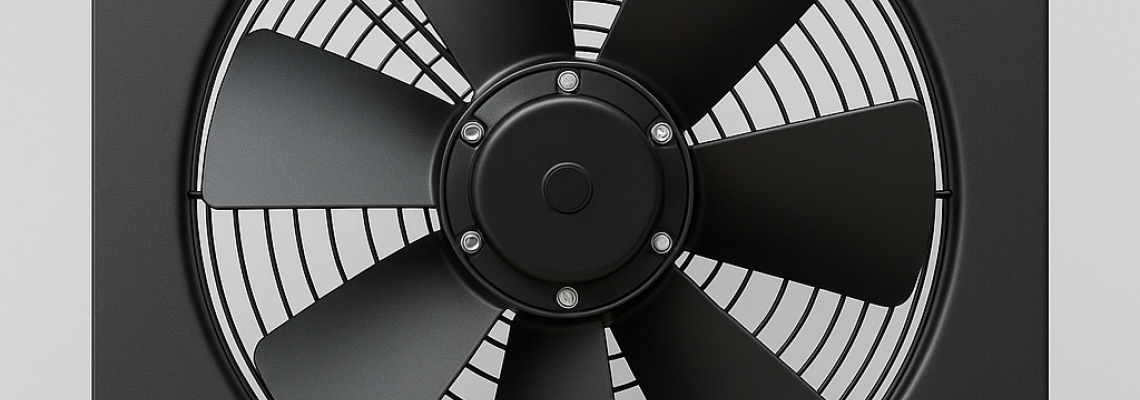Why a single-phase fan motor can’t be run much below ≈ 180 V (75 % of a 240 V motor)
| At rated 240 V & 50 Hz | When you drop the voltage while keeping 50 Hz |
|---|---|
| Air-gap flux (Φ) is set by V/ω. | Φ falls roughly in proportion to the voltage. |
| Developed torque (T ≈ k Φ²) equals the fan load torque with only a few per-cent slip. | Because Φ is lower, the maximum available torque falls with V². To keep the impeller turning, the rotor must slip more, drawing more current. |
| Stator & rotor currents are close to name-plate. | Both windings draw highly magnetising + slip current. RMS current can rise even though the applied voltage is lower. |
| The motor-mounted cooling fan spins at ~ synchronous speed, giving rated cooling air. | Cooling air drops roughly with speed³ at exactly the same time that winding loss (I²R) is rising → hot motor. |
Below about 0.75 pu voltage for a capacitor-run or shaded-pole motor:
Available torque can no longer overcome fan load torque (which itself rises with speed²), so the rotor stalls or hovers at very high slip.
Current saturates the laminations and is rich in harmonics if you’re using a triac/phase-angle controller.
The built-in cooling fan is already too slow to remove the extra I²R and iron losses.
Manufacturers therefore publish a minimum permissible control voltage (often 170–190 V in a 240 V system) to keep temperature rise inside the insulation class.
Why a three-phase motor on a VFD works far better for deep speed reduction
| Three-phase motor + VFD | What it means for your fan |
|---|---|
| Frequency and voltage are reduced together along a “constant V/f” line, so Φ stays ≈ constant. | Full flux → rated torque is available from stand-still down to perhaps 15 Hz (≈ 30 % speed) without excess current. |
| Current is proportional to load torque, not to slip. | The motor sees the same current it would at full speed for the same % load → far less heating. |
| Sinusoidal PWM (or close to it) eliminates low-order harmonics that plague phase-angle controls. | Lower harmonic copper loss and quieter acoustics. |
| You get true 120 ° phase symmetry. | Smoother torque, higher efficiency, no reliance on a start capacitor whose phase shift degrades at low voltage. |
| Most VFDs accept single-phase input and still output 3-phase. | You can upgrade even if only 230 V single-phase supply is available. |
| Speed feedback, soft-start, ramp timing, and protections are built in. | You can tune for minimum noise or power, add PID pressure control, etc. |
Caveats
Below ~25 % speed the shaft-mounted cooling fan on a standard TEFC motor also slows.
For constant-torque loads you’d fit an external “blow-over” fan; for variable-torque loads like HVAC fans the lower aerodynamic power (∝ speed³) usually keeps temperatures safe down to ~10–15 Hz.Choose an “inverter-duty” or IEC 60034-17 motor for long life at PWM voltages.
A modern EC (brushless PM) fan can give an even wider speed range with higher efficiency if you only need a fan, not a bare motor.
Rule-of-thumb comparison
| Feature | Single-phase motor + triac/autotransformer | Three-phase motor + VFD |
|---|---|---|
| Practical speed range (without extra cooling) | 100 % → ~75 % | 100 % → ~20 % (lower with external blower) |
| Efficiency at 50 % speed | Poor (Φ↓, I↑) | Good (Φ constant, I ∝ load) |
| Starting torque | Moderate or low | High |
| Harmonic noise & THD on supply | High (phase-angle) | Low (PWM with EMI filter) |
| Cost | Low motor price, cheap control | Higher initial, lower energy & maintenance costs |
Bottom line
You can’t push a line-frequency single-phase induction fan much below ~180 V because torque falls with V² while current and temperature rise dramatically.
For deeper turndown, use a three-phase motor on a VFD (or an EC motor); by reducing frequency and voltage together it keeps flux, torque and temperature under control across a wide speed range.
Here are the two Greek symbols that appeared in the previous explanation and what they mean in the context of induction-motor theory:

